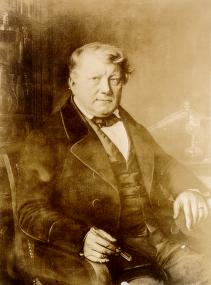Christian Friedrich Schönbein facts for kids
Quick facts for kids
Christian Friedrich Schönbein
FRSE
|
|
|---|---|

Christian Friedrich Schönbein
|
|
| Born | 18 October 1799 Metzingen, Duchy of Württemberg
|
| Died | 29 August 1868 (aged 68) Baden-Baden, Germany
|
| Nationality | German |
| Citizenship | Germany, Switzerland |
| Known for | Fuel cell, ozone, guncotton |
| Scientific career | |
| Institutions | University of Basel |
Christian Friedrich Schönbein (born October 18, 1799 – died August 29, 1868) was a German-Swiss chemist. He is famous for inventing the fuel cell in 1838. He also discovered guncotton and ozone.
Contents
Life of Christian Schönbein
Christian Schönbein was born in Metzingen, a town in what was then the Duchy of Württemberg. When he was about 13, he started working for a company that made chemicals and medicines.
He worked hard and learned a lot about science on his own. He even asked a chemistry professor at Tübingen to test his knowledge. Schönbein passed the test! After moving around and studying at different universities, he got a job at the University of Basel in 1828. By 1835, he became a full professor there. He stayed at the university until he passed away in 1868.
What is a Fuel Cell?
In 1839, Schönbein wrote about the idea behind the fuel cell in a science magazine. A fuel cell is a device that changes chemical energy into electrical energy. It's like a battery, but it keeps making electricity as long as it has fuel.
Discovery of Ozone
Schönbein was doing experiments with electrolysis of water at the University of Basel. Electrolysis is when you use electricity to split water into hydrogen and oxygen. During these experiments, he noticed a strange, strong smell in his lab.
This smell gave Schönbein a clue that a new gas was being made. Because of the strong smell, he named the new gas "ozone." This name comes from the Greek word "ozein," which means "to smell." Schönbein wrote about his discovery in 1840. He later realized that the smell of ozone was similar to the smell produced when white phosphorus slowly reacts with air.
The ozone smell Schönbein found is the same smell you might notice after a lightning storm. This smell tells us that ozone is present in the air.
Explosives: Guncotton
Even though his wife told him not to, Schönbein sometimes did experiments in their kitchen at home. One day in 1845, when his wife was out, he accidentally spilled a mix of nitric acid and sulfuric acid.
He used his wife's cotton apron to clean up the spill. Then, he hung the apron over the stove to dry. To his surprise, the apron suddenly caught fire and burned up so quickly that it seemed to vanish!
Schönbein had accidentally changed the cotton apron into a new substance. The acids added special groups (called nitro groups) to the cotton. These groups acted like an internal source of oxygen. When the apron got hot, the cotton burned completely and very fast.
Schönbein quickly understood how important this new compound could be. Before this, black gunpowder was the main explosive used in battles for 500 years. But gunpowder created a lot of thick smoke, which made gunners dirty, messed up cannons, and made it hard to see on the battlefield.
Schönbein's new substance, called guncotton (or nitrocellulose), was seen as a possible "smokeless powder." It could be used to power artillery shells.
At first, making guncotton for military use was difficult. Factories often exploded, and the guncotton burned too fast. It wasn't until 1884 that another scientist, Paul Vieille, found a way to control guncotton. He made a successful smokeless gunpowder called Poudre B. Later, in 1891, James Dewar and Frederick Augustus Abel also made a safe mixture from guncotton called cordite.
Legacy
In 1990, an asteroid was named after Christian Friedrich Schönbein to honor his important scientific discoveries.
See also
 In Spanish: Christian Schönbein para niños
In Spanish: Christian Schönbein para niños
- Timeline of hydrogen technologies
Images for kids
-
The Letters of Jöns Jakob Berzelius and Christian Friedrich Schönbein 1836 1847, London 1900


